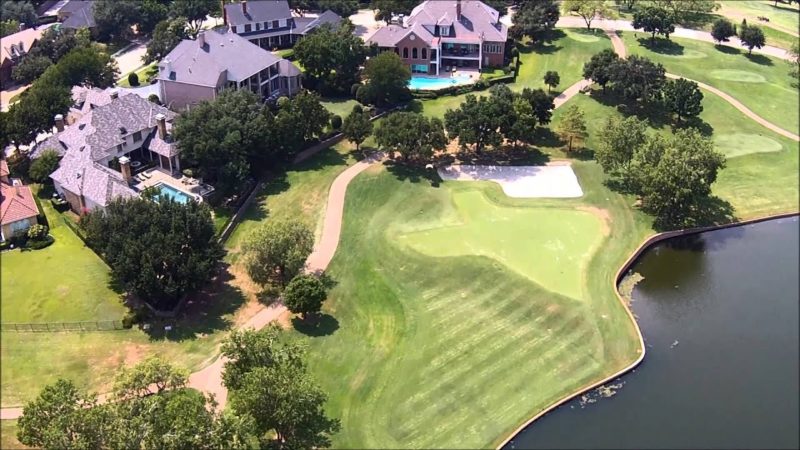Pair of spectacular courses challenge every part of your golf game
IRVING, Texas (Jan. 25, 2021) – There is nothing subtle about the golf experience you encounter at the Four Seasons’ Resort and Club Dallas at Las Colinas, but – believe me – that’s a good thing. Like seemingly everything else in the burgeoning Dallas-Fort Worth Metroplex, golf here is BIG and not for the weak or faint of heart.
At this resort, you get two great golf courses, the brutish TPC Four Seasons Las Colinas and the underrated Cottonwood Valley, which will call on all your wiles to negotiate its twists, turns and undulations. These completely different golf experiences are both highly challenging and satisfying.
The courses are part of the comprehensive, award-winning golf resort at the Four Seasons Resort and Club Dallas, the largest Four Seasons facility in the world. The resort also offers a driving range, sand-bunker practice area, putting and chipping greens, and professional private instruction from PGA-certified golf instructors.
Players enjoy myriad services, including private outings, group clinics and a golf school catering to corporate events. Also available are shoe and club rental services, an award-winning pro shop, and full-service locker rooms in the adjacent spa.
And, because the resort bears the name Four Seasons, the attention to detail throughout the facility is top-notch. Where the golf course at TPC Four Seasons Las Colinas is about as in your face as it gets, the accommodations and service are understated and purely professional, with no detail too small.
The 400-acre Four Seasons Resort and Club Dallas at Las Colinas resort, the only American Automobile Association Five Diamond resort in the state, has a look that both leisure and business travelers will enjoy.
Most of what people hear and remember about the golf here is about the TPC Four Seasons Las Colinas track. Opened in 1983, the par-70 layout was originally designed by Jay Morrish, with help from player consultants Byron Nelson and Ben Crenshaw. Former PGA Tour champion D.A. Weibring and his partner, architect Steve Wolfard, revamped the course at the TPC Four Seasons Las Colinas, home to the PGA Tour’s HP Byron Nelson Championship, after the 2007 edition of that iconic tournament.
Since then, every hole has been rebuilt for a clean, traditional look with an emphasis on shot value and creativity around the greens. The changes created optimum playing conditions and developed a more challenging and classic layout for both professionals and amateurs.
The Plano, Texas-based Weibring said the changes were made with a singular purpose in mind: to produce a layout that would have made the late Nelson proud past. “The one common denominator was Byron,” Weibring said. “I said if we do something first class out of respect for Byron, then everything will work out.”
The big-shouldered track, which stretches 7,166 yards from the tips where it carries a rating of 76.0 and a 142 slope, features rolling hills, indigenous oak and mesquite trees, numerous sand bunkers, and small scenic lakes on a number of the holes, including the two finishers.
Its defining characteristics are square-tee complexes, white-sand bunkers and closely mown areas around the greens. In the renovation, mounds were softened for a more natural look and to provide better sight lines. About 165 trees were also moved. The renovation was so successful that it was named as Resort Course Redesign of the Year by Golf Inc. magazine in 2008.
Bulk up to Play the TPC Track
When you step up the first tee on the course at TPC Four Seasons Las Colinas, your starter is ready with a gift of a divot-repair tool, a yardage book and advice as to your aiming point. Take the gift, because it’s the last one you are going to get in your round, as the course will extract its pound of flesh from even the best players.
The 458-yard par-4 opener offers a challenging start to the course with a fairway lengthened 65 yards and the green moved and elevated to the east to create a more prominent dogleg-right. There’s a fairway bunker to the right to keep you from cutting over the corner, guarding the left and right side of the green.
No. 2 is a 221-yard par-3 tester with three bunkers left, right and rear of the green, which has a ridge running from the front-left to the back-right. After managing to survive this opening duo, you’re hit in the face with the 528-yard par-4 (that’s right, par-4) third, which features a contoured fairway and a lake running the full length of its right side. A fairway bunker and a rolling, triangle-shaped green is bunkered left and right to squeeze the approach.
The 431-yard fourth is defined by a seven-bunker complex along the right that tightens the fairway pushes play closer to water on the left. Two more bunkers guard the front-right entry to a tough, rolling green. No. 5, which once shared a green with the ninth hole, is now a standalone jewel and one of the few holes you can try to score on the front side. At 174 yards, the par-3 ends at a gently sloping putting surface protected by bunkers front-left and right.
Use the single, overhanging tree as your target on No. 6, a 448-yard par-4 with a smallish green guarded by a U-shaped bunker that must be carried. The seventh is a dogleg-left, 542-yard par-5 that rises along its entire length. The second shot now must navigate three traps left and two on the right – and a off-camber fairway that pushes shots left. Two more bunkers guard the front-left and back-right of a green with a steep front slope.
The 461-yard par-4 eighth descends gently from the tee to the green. The slight dogleg-right has trees framing both sides of the hole. A large bunker guards the left side of the fairway at the turn, and the green is bunkered on the right. But the hole is most notable for the dramatic contouring around the putting surface.

The front nine ends with a 427-yard par-4 that is deceptive because of the crosswinds that can push a tee shot towards water that runs along the right side. Trees along the left define the hole, with one tree encroaching into the line of play. Bunkers here are found on the right side of the fairway and a bunker left of the green.
The second nine at TPC Four Seasons Las Colinas requires all your skills, thanks to a wonderful variety of risk-reward holes and ones that you just have to grind out. The 435-yard 10th is fitful because of a bunker on the left side midway down the fairway, and trees on the right. Bunkers front-right and back-left guard the green. The short (323-yard) par-4 11th can be reached by longer hitters, but it will require a carry over water that runs the entire length of the hole. Even a prudent play is tricky as the fairway landing area is narrow, and the green – though large and inviting – has tricky contouring and small bunkers front-right, left and back-left.
No. 12 is a 455-yard, dogleg-right par-4 sporting a bunker at the beginning of the fairway on the right and two others down on the left. A large bunker guards the green approach on the right, while another challenges on the back-left. The 13th, a 180-yard par-3, looks easier than it is – mostly because the rolling green will lead to a potential three-putt if you don’t place your tee shot on the correct spot.
Many members at TPC Four Seasons Las Colinas consider the track’s 406-yard 14th as its signature hole because of the need for near exact placement off the tee and the combination of trees and water to deal with on the approach. You must avoid a lake off the tee. The hole then bends sharply to the right to bring that lake and a creek in front of the green back into play.
The 504-yard 15th again hammers you with length and placement off the tee. The hole then veers to the left and must be played around a strand of trees. No. 16, the lone par-5 on the back, plays 546 yards and rises in elevation from the tee to the green. Bunkers along the left and in the fairway’s midsection are visible from the tee and will require some skill to navigate around. Shaping around the green makes this hole one of the most challenging on the course.
The TPC ends with two holes enhanced by Weibring to heighten the drama. The 198-yard par-3 17th plays into an amphitheater-type bowl; its reshaped green allows players to feed their tee shots toward pin placements near a pond on its front and right edges. A bailout left brings a bunker into play and is no picnic either.
From high above the 17th green, the tee at No. 18 provides a dramatic view of the natural contours of the 429-yard, par-4 hole. Also on view are four new lakes that extend from the landing area all the way to the green. This slight dogleg-left offers an exciting finisher that tempts player to go for a birdie: a beefy and fitting end to a no-holds-barred golf course.

Cottonwood Valley Brings Finesse Back into Play
Right across the street from Four Seasons Resort and Club Dallas is the par-71, 7,120-yard Cottonwood Valley Golf Course. This layout boasts a 74.9 course rating and a 136 slope from the tips. Serving as the home course for members of The Sports Club at Four Seasons, it brings the need for finesse into play, especially after the whipping you likely received at TPC Four Seasons Las Colinas.
Cottonwood Valley features rebuilt bentgrass greens and tees, strategically placed bunkers, all situated on the rolling hills of Las Colinas. Water comes into play on nine holes as the course runs partly through a residential community containing some mind-boggling homes that typify high-rolling Dallas.
The signature hole is its opener, a 480-yard par-4 boasting a green designed in the shape of Texas guarded by an Oklahoma-shaped bunker and a lake resembling the Gulf of Mexico. Thankfully, the wide fairway allows aggressiveness off the tee.
The short (170-yard) and downhill par-3 second plays into a wide-but-shallow green that is guarded by deep traps. The green is bisected by a ridge that makes the actual target very small. This seemingly harmless one-shotter statistically ranked as the second-hardest hole on the 2000 PGA Tour due to severe crosswinds that make club selection so difficult.
There is no quarter given at the 590-yard third, a par-5 for the resort golfer that plays as a 500-yard par-4 when the PGA Tour players tee it up at Cottonwood Valley. The drive must avert a series of fairway bunkers, while a long second shot must play into a small plateau-shaped green that demands accuracy. Chipping is difficult because of the elevated green, so par is a good score here.
No. 4 is Cottonwood Valley’s top handicap hole as it stretches 440 yards and runs slightly uphill to a large green that will hold a long-iron shot. The 440-yard par-4 fifth has one of the more difficult drives on the course, thanks to a dogleg-right fairway that requires both accuracy and length off the tee. Once the tee shot is negotiated, a short- to mid-iron can be played to a split-level green, and water lurks to the right of the green.
The 390-yard sixth is a downhill par-4 and an excellent birdie opportunity. A bunker rests left of the fairway at about 250 yards out, while and another sits about 280 yards along the right. In certain wind conditions, players can drive over the bunkers. The approach is usually just a wedge to the green, which is ringed by bunkers. No. 7 is a soft dogleg-right guarded by trees and deep bunkers right and left, making accuracy more important than distance. An accurate tee ball will allow for a short-iron to a wide-but-shallow green, around which lurk deep bunkers.
The 395-yard eighth is considered the easiest par-4 at Cottonwood Valley. The tee shot must hit an elevated plateau that blocks views of the green. The second shot then descends to a green guarded by a grass bunker left side and sand traps right. Club selection is difficult here as the winds tend to swirl in this section of the course. The front nine concludes with a tough 185-yard par-3 with a large, deep bunker that cuts into the back middle-right of the generous green, which slopes from back to front. A pond short and left also enters play.
The inward nine begins with a 435-yard par-4 that sports another tight fairway. The 10th, the course’s second-highest handicap hole, is highlighted by a two-tiered, elevated green that serves as a large target for a mid-iron approach. If you’ve lost a shot or two, you might be able to get a shot back at the 550-yard 11th. Here an elevated tee provides a great vista for a beautiful par-5 that is reachable with a long drive. Heavy rough and small mounding on both sides of the fairway will make it a three-shot hole for balls off the fairway. The green is large and severely undulating and guarded by water back and right.
No. 12 is a 200-yard par-3 with a large dome-shaped green as its main defense, while the 415-yard par-4 13th will again test your accuracy off the tee. The 13th green has several ridges, providing several pin placements; a large and deep bunker on the front-left guards the toughest of them. No. 14, a dogleg-right par-4 with water left and two bunkers right, asks for accuracy as well despite its 440-yard length. The second shot is uphill to a huge putting surface that narrows in the front and slopes severely from back to front.
The par-4 15th hole at Cottonwood Valley plays to 430 yards and is one of course’s premier holes. The tee shot is framed by dense trees and the fairway bends sharply at 250 yards out. The second shot heads uphill to a green that slopes severely back to front and is bisected by a ridge across it. After taking your lumps on No. 15, the 16th can provide a bit of a respite if you can get your tee ball to the right-center of the fairway of this 540-yard par-5 jewel. An oval-shaped, wavy green is guarded by a deep bunker in the front-right, but a birdie is still a real possibility.

No. 17, the longest of the par-3s at 200 yards, plays to an undulating and wide green. Bunkers on the left flash up to make for a small target; the prevailing wind is behind, so take dead aim and perhaps a club less than usual.
A round at Cottonwood Valley ends with the tough-as-nails 435-yard par-4 18th, a great closing hole that requires a drive that must be kept toward the left side because a thick stand of trees blocks the right third of the fairway. A 250-yard drive to a plateau leaves the best angle and lie for the approach, and the second shot is a mid-iron shot to a generous green with bunkers and grass swales around it. The pin is normally on the front-right, which creates the most difficult spot to reach and putt on.
When you play the two courses at the Four Seasons Resort and Club Dallas, keep two things in mind: bring your “A” game to both the TPC and Cottonwood Valley courses. You’ll quickly realize that you’ve been challenged by a pair of courses that have tested the game’s best.


